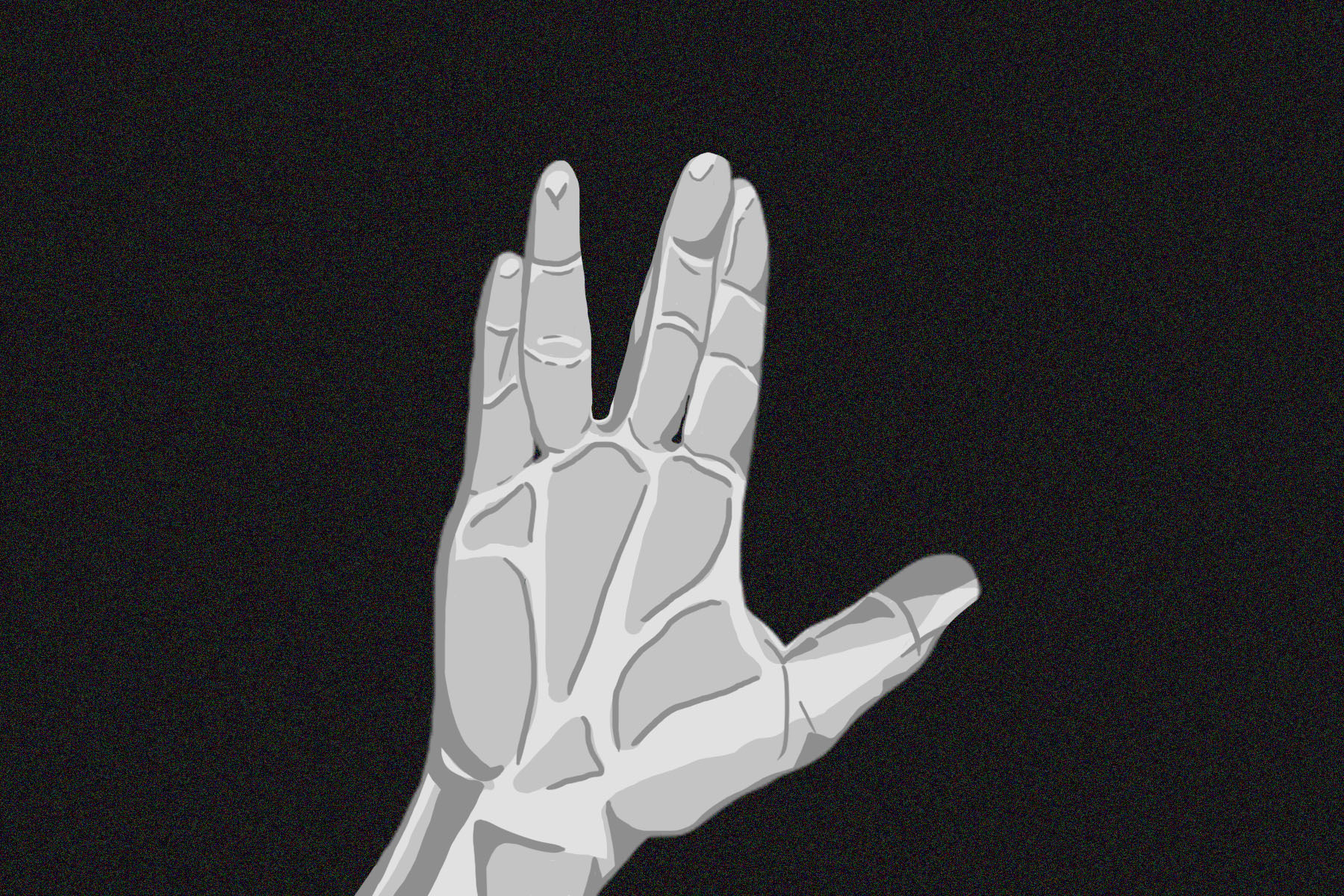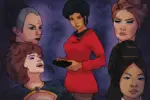“Risk! Risk is our business,” proclaimed a passionate Captain Kirk in the original “Star Trek” series, which ran from 1966 to 1969. The show was “boldly going where no one had gone before,” even receiving admiration from Martin Luther King Jr. for its progressive messages in a time of sweeping social change and political tension: the United States was locked in a space race with the Soviet Union, the civil rights movement had caught the world’s attention and the Vietnam War continued to escalate among other military conflicts of the decade.
Thinly veiled behind cheesy cardboard set pieces and prosthetic ears, “Star Trek” not only touched on these events but actively made social commentary integral to the identity of the show. Despite the apprehension surrounding topics like the civil rights movement, the Soviet Union or World War II, creator Gene Roddenberry populated the command of the show’s starship, the U.S.S. Enterprise, with a diverse ensemble that included Russian and (ambiguously) Asian navigational officers Chekov and Sulu, respectively, and a Black communications lieutenant named Uhura. “We will find it impossible to fear diversity and to enter the future at the same time,” stated Roddenberry.
The integration of a sci-fi future and social commentary did not stop at the casting, however. Where other sci-fi shows at the time indulged in the novelty of meeting little green men and exploring unusual planets, “Star Trek” took those premises seriously, asking the same questions of a fictional world that many were asking in our own: “How can we all get along?” Many attempts to answer this question within “Star Trek” were done in the context of race.
The iconic Mr. Spock is biracial, struggling with the cultural dissonance of being half-human and half-Vulcan, feeling obligated to choose one identity over the other. The Klingons are met with hostility from our protagonists and their allies in a way that mimics Cold War tensions from the era. Despite being the “Big Bad” for many original “Star Trek” episodes, the problems of generalizing the entire Klingon race as cruel and evil people were also explored in the series.
The expansion of “Star Trek” into sequel series, spinoffs, movies and books only furthered the allegorical scrutiny of racism and racial identity. Shows like “Star Trek: The Next Generation” and “Star Trek: Voyager” worked beyond simply restating the same themes by addressing familiar moral topics from perspectives that weren’t always permitted during the original run of “Star Trek” in the 1960s. Episodes about sexuality, gender identity and economic disparity also developed as time passed, and the racial themes of “Star Trek” continued to evolve (although not without the occasional step backward).
More than 50 years have passed since the initial airing of “Star Trek.” With a total of eight shows and over 700 hours of content, covering the entire franchise and its various examinations of racism would require a word count measured in lightyears. Instead, these 3 episodes exemplify narrative perspectives that are used frequently within the franchise to address racism on different levels:
1. “Let That Be Your Last Battlefield” (The Original Series, S3E15)
Originally broadcast in 1969, “Let That Be Your Last Battlefield” lives up to its grim title. To summarize, Captain Kirk and his crew stumble across two aliens named Bele and Lokai: Both are pigmented with one side of the body that is white like snow, the other black like charcoal. At first seemingly identical, the two are pigmented opposite colors on opposite sides, which apparently delineates two different races.
Bele attempts to pursue Lokai around the starship, claiming that he is a fugitive and belongs to an inferior race. Lokai, meanwhile, retorts that he is a freedom fighter, demanding asylum from Bele. The crew itself is largely uninvolved in the warring between Bele and Lokai, as the two have powerful abilities that make intervention impossible. The crew can only watch as the two return to a home decimated by war. Enraged and blaming each other for genocide, the two fight to the death, bringing their species to extinction.
“Let That Be Your Last Battlefield” was well-received upon its release, often being ranked in the top 20 “Star Trek” episodes, but has occasionally garnered criticism for its didactic social commentary. Indeed, the allusions to racism are far from subtle. A line of dialogue, “It is obvious to the most simple minded that Lokai is of an inferior breed … I am black on the right side,” highlights the trivial nature of the alien’s bigotry in a moment of unmistakable exposition.
But while the A.V. Club remarked that the “message [of the episode] is so overpowering that it’s hard to remember anything else,” the caricatured nature of the episode’s makeup and dialogue ultimately strengthens the takeaway: racism and prejudice are inherently absurd. What “Let That Be Your Last Battlefield” demonstrates is a “third person” perspective in which the crew (and audience) act primarily as an observer.
Because these aliens do not discriminate by the same metrics humans do and the crew has such little context to explain the prejudices of Lokai and Bele, their overacted seething may be just enough, in juxtaposition with the composed crew of the Enterprise, to raise the question of how we as humans would look in that same position. If all our human prejudices met with the confusion of a faraway species, how ridiculous and overacted would we look, too?
2. “The Drumhead” (The Next Generation, S4E21)
“Star Trek” had explored race-driven paranoia before “The Drumhead” — Mr. Spock in the Original Series was once suspected as a spy after it was revealed that his pointed ears are also a trait found in the mysterious Romulans, another common “Star Trek” adversary. What is unique about “The Drumhead” is that the main plot line revolves around this racial paranoia, whereas the Original Series episode arguably featured this bigotry against Spock as a subplot.
In “The Drumhead,” protagonist Captain Picard is tasked with investigating an explosion on his starship alongside an acclaimed admiral. After interviewing several crew members, the admiral discovers that an officer lied about his race in an application to work (he was one-quarter Romulan, descended from the villains, which he tried to cover up). This prompts her, based on his lineage —and despite the lack of evidence — to charge the officer with sabotage. Captain Picard quickly begins to object to the trial and the admiral’s accusations, as the proceedings slowly devolve into a witch hunt. Eventually, Picard finds himself in the courtroom having to defend himself from attacks against his character and intentions.
Picard, who takes a much more active role in this episode than Kirk did in his, becomes the catalyst for what could be referred to as a “second person” perspective: essentially the shift in viewing prejudice from a “third person” to “first-person” point of view. While the audience already sympathizes with the officer for being accused of a crime based on his racial background, as soon as Picard is dragged into court to defend himself, the audience is as well. Captain Picard is not only the person whose point of view guides the narrative, he is also the character audiences have come to understand the most. By shifting the blame to him — the vessel for the audience — viewers can no longer watch the irrationality of prejudice unfold from the sidelines.
Some may recall Martin Niemöller’s “First they came…” upon watching “The Drumhead.” While it could be argued that the racial component of this episode is merely a device used to convey the larger theme of rampant, unfounded persecution, that is exactly the point. The race of the officer was a shallow (but frequently used) excuse to, as Picard articulates in the episode, “[spread] fear in the name of righteousness.” Allusions to McCarthyism have been made when discussing the episode’s core theme of persecution, but examples from the 21st century (for instance, the NYPD Muslim Surveillance Program) are unfortunately just as relevant.
3. “Far Beyond the Stars” (Deep Space Nine, S6E13)
Something in common between the previous two episodes is the reliance on allegory to convey real-life prejudices. “Far Beyond the Stars” is different, putting the audience in a “first-person” perspective as the protagonist is attacked, mocked and beaten for his race, not as a Romulan or a Klingon, but as an African American.
In the episode, a Captain Sisko (played by Black actor Avery Brooks, who also directed the episode) finds himself in 20th century New York City as Benny Russell, a science fiction writer. Flashing back and forth between his life as Captain Sisko and his life in New York City, Russell becomes determined to publish these “visions” for his employer — the sci-fi magazine titled “Incredible Tales.”
Despite the sudden inspiration, Russell is discouraged from writing about a Black lead character. Not only that, but he is excluded from press photos, questioned by police, mocked for his writing job and is a witness to the death of his young friend, and eventually ends up beaten by police himself. The next day at work, the refusal to publish his story of “Captain Sisko” sends Russell into despair. He passes out, eventually waking up as Sisko once more, but not before hearing the words, “You are the dreamer, and the dream.”
“Far Beyond the Stars” and its real depiction of systemic racism and police brutality hits with a weight that is rare in the usually fantastical universe of “Star Trek.” The series was not founded with the goal of distracting viewers from hurt so much as it was made to bring attention to the very issues that plague the world each day.
The story of Benny Russell acts as a shattering of the fictional veil, bringing a powerful Captain back into the world of a man just trying to survive, and the viewers along with him. The last exclamations from Russell — perhaps epitomizing “Star Trek” — refutes the idea that accepting this reality is the path forward. There is a difference between acknowledgment and acceptance, after all: “You can pulp a story, but you cannot destroy an idea!”

















